7 Things About Double Black Diamond Ski Runs You Really Need to Know
If you’ve spent much time at ski resorts, it’s likely you’ve seen large signs with a double black diamond symbol and a warning for expert-only terrain. So what is a double black diamond? The double black diamond is the most difficult rating for ski runs, and these areas put skiers face-to-face with extreme grades, sheer cliffs, narrow chutes, dense trees, and unmarked obstacles. These runs can be very dangerous and should only be attempted by experienced skiers.
In this article, I’ll walk you through seven key points about double black diamonds, and takeaways from my personal experience skiing these challenging runs. Read on to learn about the most difficult and dangerous ski resort rating.

1. How Ski Run Ratings Work
To get some perspective, it is helpful to understand how ski resorts rate difficulty and where the double black diamond falls on the scale. America and Europe use similar rating systems to communicate difficulty, but there are a few differences.
While the exact differences between ratings may vary from resort to resort, understanding the rating system can help you know how difficult a ski run is and what terrain you may encounter. At the top of each ski run, resorts will post large signs indicating the rating so you can find routes that match your skill level.
Trail rating symbol double black diamond
American Ski Run Ratings
- Green Circle: This is the easiest rating. These runs have relatively flat grades and are groomed by snowcats regularly, so the snow conditions are more predictable. Green circles are beginner terrain, so if you’re new to skiing, this is where to start.
- Blue Square: These runs are considered intermediate terrain. The main difference from green circles is that runs are steeper and allow for higher speeds, meaning more control is required. Just because you can ski faster doesn’t mean you always should.
- Black Diamond: This rating marks runs for advanced skiers. Grades can be steeper than 40%, so to ski a black diamond you need to know how to control your speed. Black diamond runs may not be groomed as regularly as easier runs, so be prepared for more challenging snow conditions including ice, moguls, and chopped powder.
- Double Black Diamond: The most difficult rating for American ski resorts, double black diamonds are expert-only terrain. While other ski runs are usually cleared of trees and obstacles, double black diamonds are mostly natural terrain, which means unmarked obstacles, rocks, trees, and extremely steep grades.
European Ski Ratings
- Green: These runs are great for just starting out. They have very gradual slopes and well-maintained snow.
- Blue: For beginner to intermediate skiers, blue runs are the perfect place to progress your skills.
- Red: This rating indicates intermediate to advanced skiing. Red ski runs can have steep grades up to 40%
- Black: In Europe, black runs are expert terrain. These runs have steep grades, and often have moguls or other varying snow conditions. Though there is no double black diamond rating in Europe, many ungroomed black runs are equivalent.
2. Features of Double Black Diamond Terrain—What is a Double Black Diamond?
Wondering what makes a ski run worthy of the double black diamond rating? The main differences between double black diamonds and other ski runs are natural terrain features like cliffs, chutes, and unmarked obstacles. Here’s a breakdown of what you can expect to encounter on many double black diamond runs.
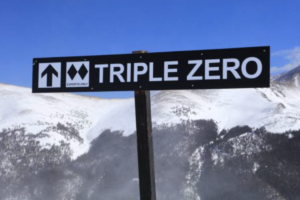
Double Black Diamond Angle or grade
Double black diamonds almost always feature extreme grades above 40%. This means it is easier to lose control or crash, especially in bad snow conditions. Steeper grades require a skier to have both stellar technique and impressive leg strength to stay in control.
Cliffs and Drops
One of the biggest differences between double black diamonds and any lower ratings is the presence of large natural rock features like cliffs and drop-offs. One of the biggest dangers of skiing in double black diamond terrain is the possibility of skiing off the edge of a cliff you didn’t notice until it was too late.
Narrow Chutes
A chute is a narrow, steep section of snow between two walls or ridges of rock. Chutes create an additional challenge on already steep routes because they don’t give much room for turning. I’ve encountered chutes as narrow as 3 m (10 ft). Imagine trying to stay in control of your speed while rocketing down such a narrow path of snow. And if you lose control, the jagged rocks at either side don’t make for a nice landing.
Tree Cover
Because double black diamonds are mostly natural terrain, you can expect to encounter dense tree cover. Skiing down steep runs covered in pines requires focus and near-perfect turning skills. You have to time each turn just right to fit between trees and avoid a collision.
Unmarked Obstacles
In most ski resort areas, rocks, drop-offs, and other hazards on the slope will be marked by flags or ropes so you know what to avoid. This is rarely the case on double black diamonds. There are often so many such obstacles that it’s impossible for ski patrol to mark them all. I’ve often been skiing in perfect untouched powder only to grind over a hidden rock band, damaging my skis and often sending me crashing to the ground. It is up to the skier to recognize and avoid potential obstacles.
3. Double Black Diamond Runs Are Ungroomed
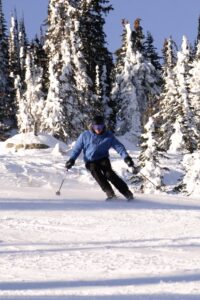
For most ski runs, resorts typically use snowcats to groom the snow regularly to create an even, smooth skiing surface. In contrast, most double black diamond runs are never groomed and follow natural terrain features. This means snow conditions on these runs are natural and rarely maintained by the ski resort.
Many advanced skiers love venturing into these areas just for this reason. You are much more likely to find perfect, untouched powder than on a busy intermediate ski run. You can also more likely to run into challenging snow conditions like ice, crust, moguls, and hardened chopped powder.
4. Double Black Diamonds May Not Have Ski Patrol
One thing you may not know about double black diamond ski runs is that they often are not patrolled regularly. If you crash and are injured in a double black diamond area, it can take much longer for ski patrol to find and rescue you. It is best practice to never ski alone on expert terrain.
In many areas double black diamonds also don’t have the same avalanche control as the rest of the resort. These ski routes will often be roped off with only a few entrance gates that are open or closed based on the snowpack conditions.
If you ski in double black diamond terrain, know that you are doing so at your own risk. You are always responsible for your own safety.
5. Expert-Only Terrain
Double black diamond ski runs are considered expert-only terrain, and you’ll often see this term on signs at the entrances to these runs. This is a serious warning. Crashes and injuries are common on black diamond runs, and rescues are difficult. Skiers are expected to know what they are doing and have the skills to get down a run safely.
You should only attempt double black diamond ski runs after you have several years of skiing experience and have mastered several key skills.
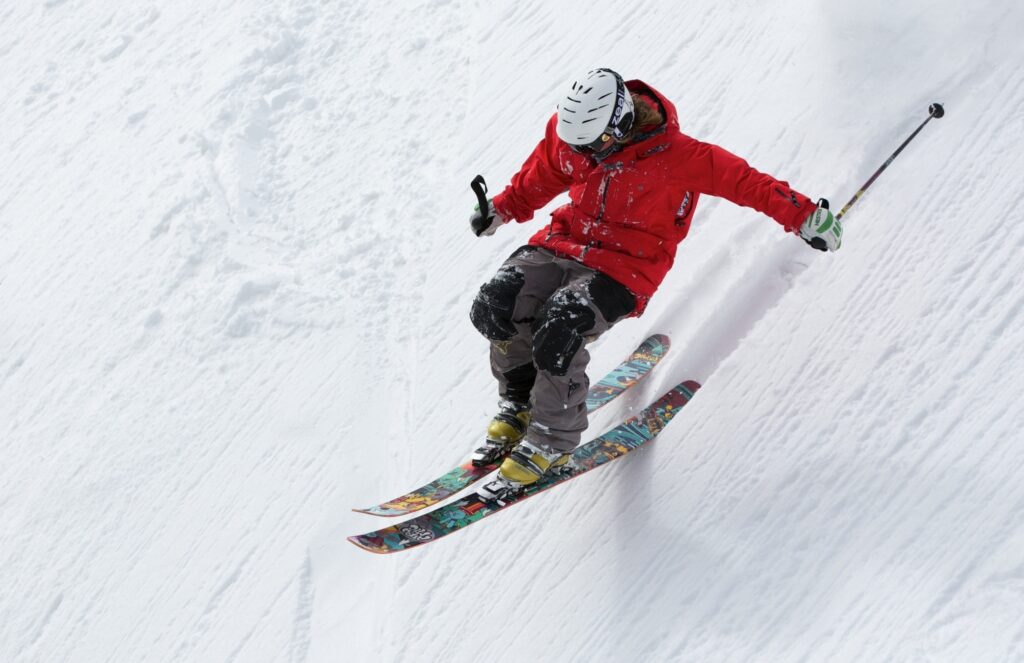
6. Skills for Skiing Double Black Diamonds
Now you know some of the risks and demands of skiing in black diamond terrain, let’s go through what skills you need to ski these runs.
Precise Turning and Stopping
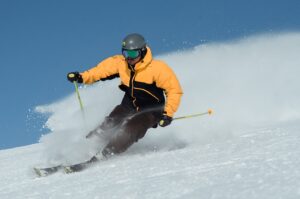 Because double black diamonds feature obstacles like rocks, cliffs, trees, and chutes, it is absolutely essential for you to master tight turns and be able to stop at a moment’s notice. High-speed carving is no help when you’re weaving between trees and rocks.
Because double black diamonds feature obstacles like rocks, cliffs, trees, and chutes, it is absolutely essential for you to master tight turns and be able to stop at a moment’s notice. High-speed carving is no help when you’re weaving between trees and rocks.
I once didn’t notice the edge of a large cliff until I was a second from going over it. If I hadn’t been able to stop at a moment’s notice I would have skied right off the edge.
Side Slipping
In black diamond terrain, it is almost inevitable you will run into sections that are too difficult for you to ski safely. You still need to get down the hill though. This is where a technique known as side slipping comes in. Side slipping is where you slowly slide sideways down a mountain while keeping your skis pointed horizontally to the slope. It allows you to descend slowly and stay in control when a section of a run is too difficult.
When I run into dangerous chutes or other features I’m uncomfortable skiing, I will use slide slipping to slowly lower myself past the hazardous area.
Physical Conditioning
 The steep grades, difficult snow conditions, and obstacles in double black diamonds make these runs extremely taxing to ski. A skier venturing into expert-only terrain needs to have massive strength built up from years of skiing.
The steep grades, difficult snow conditions, and obstacles in double black diamonds make these runs extremely taxing to ski. A skier venturing into expert-only terrain needs to have massive strength built up from years of skiing.
Reading the Terrain
Being able to ski double black diamonds isn’t just about your own skiing skills but also requires you to be able to look ahead of you and recognize potential obstacles, hazards, and the safest route down. You need to know what a rock buried under the snow looks like, where cliff edges may be, and what forested areas are too dense to ski.
It is always a good idea to become familiar with the terrain of a run you want to ski. I will often first ski through an area very slowly to notice obstacles, cliffs, and safe routes. Then I can come through a second time with confidence.
7. Going Beyond the Double Black Diamond
Is double black diamond the hardest?
It turns out the most advanced ski runs in the world are not in resorts and can’t be accessed with a ski lift. Many skiers want to reach the incredible terrain outside of resorts. This is where backcountry skiing comes in.
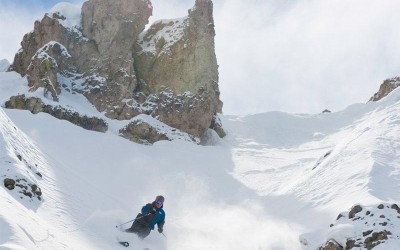 Backcountry skiing is any skiing outside a resort where skiers make their own way to the top of a slope by hiking or using specialized climbing skins that make their skis stick to the snow going uphill. Backcountry skiers can reach
Backcountry skiing is any skiing outside a resort where skiers make their own way to the top of a slope by hiking or using specialized climbing skins that make their skis stick to the snow going uphill. Backcountry skiers can reach
This discipline involves even more risk and requires more knowledge than even the most advanced resort skiing. Backcountry skiers need to understand avalanche safety and carry equipment for avalanche rescues. It is absolutely essential to take an avalanche safety course before skiing backcountry. There is no ski patrol or rescue team outside the resort.
So if you progress to expert skiing and want to explore even more terrain beyond resort double black diamonds, backcountry skiing is a way to get to places few other people ski. Just make sure you get the knowledge to stay safe.
Key Takeaways in 3 sentences
- The Double black diamond is the most difficult run at resorts.
- Extreme grades, dense trees, narrow chutes, cliffs, and unmarked obstacles often exist in double black diamond areas.
- You should only attempt skiing a double black diamond after you have mastered all of the lower ratings and skills for skiing on difficult terrain. You can learn about skiing safely in this post
Summary of the double black diamond
- Double black diamond ski runs are the most difficult and dangerous rating for ski resorts
- These runs are reserved for expert skiers and feature extreme grades, cliffs, narrow chutes, dense trees, and unmarked obstacles
- Ski resorts in America and Europe use similar rating systems to communicate difficulty, with double black diamonds being the most difficult in America and black runs being equivalent in Europe
- Double black diamonds have extreme grades above 40% and large natural rock features such as cliffs and drops
- Narrow chutes and dense trees can also be found on these runs, as well as unmarked obstacles and varying snow conditions
- Skiers should be prepared for the challenges of double black diamond runs and only attempt them if they are experienced
- Ski resorts post large signs indicating the rating at the top of each run to help skiers choose routes that match their skill level
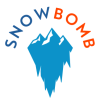
 About the author
About the author